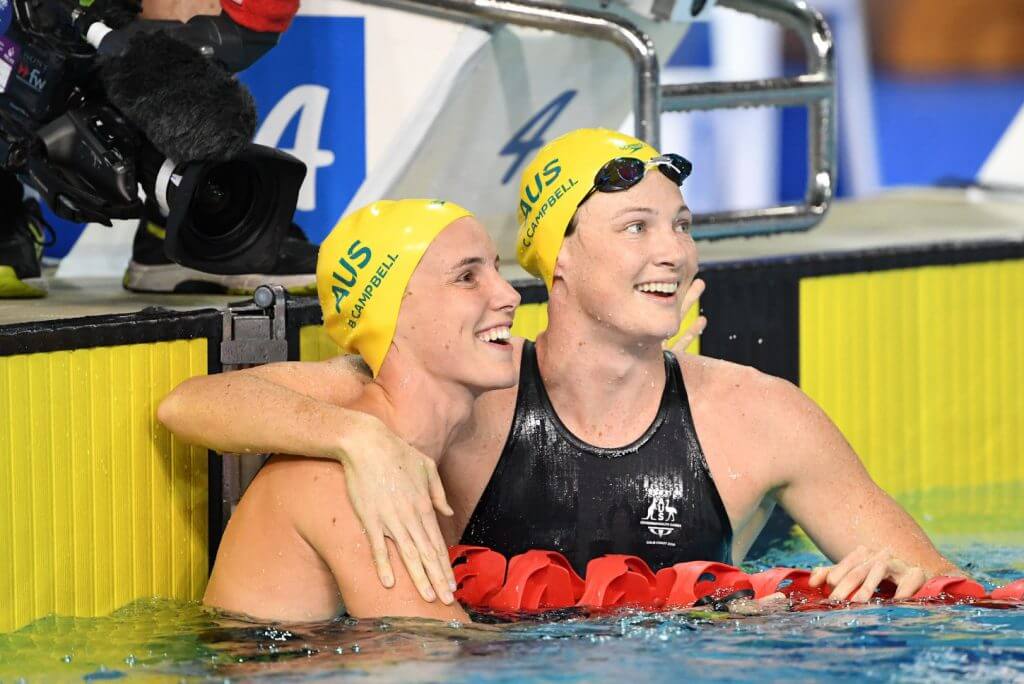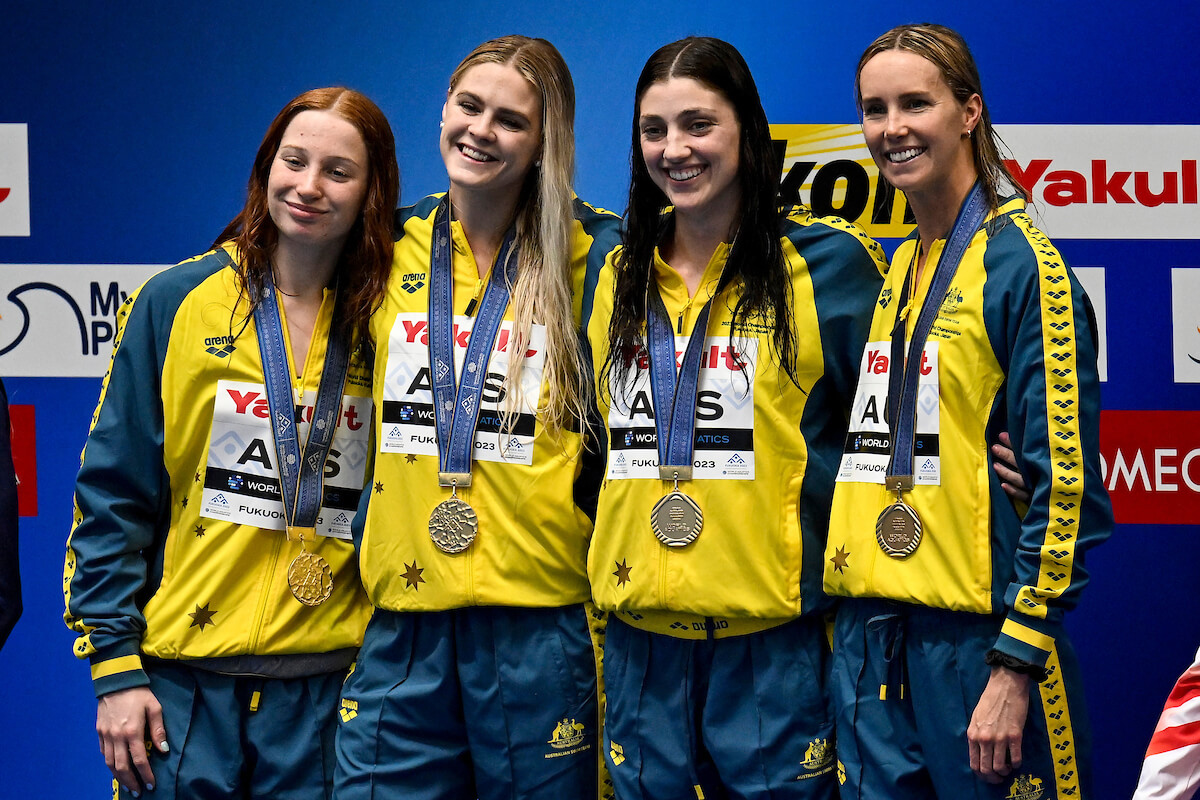Could Addition of Campbell Sisters Make Aussies More Dominant in Sprint Freestyle?

Editorial content for the 2023 World Aquatics Championships is sponsored by FINIS, a longtime partner of Swimming World and leading innovator of suits, goggles and equipment. Could Addition of Campbell Sisters Make Aussies More Dominant in Sprint Freestyle? In recent months, a four-time Olympian and one of the greatest relay swimmers in history has made progress in her comeback to swimming while her younger sister, a world champion in her own right, is also on the way back. Cate Campbell and Bronte Campbell have both taken part in two consecutive Australian Olympic titles in the women’s 400 freestyle relay. With both Campbell sisters on the squad, the Aussies have not lost this relay since the 2013 World Championships. But at this stage of their careers, it’s hard to imagine the returns of 31-year-old Cate and 29-year-old Bronte to be a major boost for Team Australia internationally. Not because of doubts about their own abilities — both have posted strong times in this latest chapter, including in Bronte’s pair of wins over the weekend at the New South Wales State Championships. Rather, it’s because Australia’s women boast the world’s strongest collection of sprint freestylers by a substantial margin. In a world-record setting performance in the 400 free relay at this year’s World Championships, Australia won by almost four seconds over the United States while beating the world record set by an Aussie squad including both Campbell sisters at the Tokyo Olympics. In Tokyo, Mollie O’Callaghan was a prelims relay swimmer awaiting her chance at individual glory. Now, O’Callaghan is the two-time world champion in the 100 free and the world-record holder over 200 meters. O’Callaghan’s 100-meter world-title winning time of 52.08 made her the sixth-fastest performer in history while Shayna Jack, who did not even race the individual 100 free in Fukuoka, swam a time of 52.28 to move to ninth all-time before splitting as fast as 51.53 in relay duty. Mollie O’Callaghan, Shayna Jack, Meg Harris & Emma McKeon won 400 free relay gold for Australia at the World Championships — Photo Courtesy: Andrea Staccioli / Deepbluemedia / Insidefoto O’Callaghan and Jack were joined by Meg Harris and Emma McKeon on the title-winning relay squad at Worlds, with Harris splitting 52.29 and McKeon going 51.90. McKeon, also 29, has been a constant on this relay for a decade, and while she is no longer swimming at the same elite level as she was in her seven-Olympic-medal performance two years ago, but she still won three relay medals and made three individual finals this year. Harris, 21, was eight tenths quicker than her split on the gold-medal relay in Tokyo. The resulting performance was a long-awaited one, with the Australian swimmers all producing their best splits when it counted, and that allowed the group to skip over 3:28 altogether and set a new world record of 3:27.96. So dominant were the Aussies that Harris was the only member of the squad whose split was surpassed by any non-Aussie swimmer — but only by two others, with world-record holder Sarah Sjostrom leading off in 52.24 and American Kate Douglass anchoring in 52.28. Only 11 swimmers hit 52-second splits in the final, and the Aussies had four. It could have been five, with veteran Madison Wilson left off after going 52.74 in prelims. Already, this new generation of Aussie sprinters has made a significant impact on the all-time list. Consider that five of the top 10 swimmers ever in the 100 free are from Australia: 1. Sarah Sjostrom (SWE), 51.71 (2017) That’s the mix that the Campbell sisters will try to break into in hopes of a return Olympic trip. The Campbells will have to swim near their lifetime bests to sniff the finals relay for the Paris Olympics, and the unreal depth in the country means a time around the 53.09 that Bronte swam leading off the gold-medal relay in Tokyo might not be enough for even a top-six spot at next year’s Australian Trials. Qualifying in the 50 free won’t be an easier task either, with McKeon hoping to earn a return trip to the Olympics as defending gold medalist and Jack coming off a sizzling 24.01 silver-medal swim at Worlds this year. Harris was the co-bronze medalist in the splash-and-dash at the 2022 Worlds, and she did not even qualify for the event this year. For two Olympic cycles, the Campbell sisters paced Australia to 400 free relay dominance, and for any other country in the world, the additions of Cate and Bronte, even at this stage of their careers, would significantly raise the bar on a relay squad’s potential, even a U.S. squad considered the consensus No. 2 team in the world. But this crop of Australian sprinters is already the best ever assembled on the international stage.


2. Emma McKeon (AUS), 51.96 (2021)
3. Cate Campbell (AUS), 52.03 (2018)
4. Simone Manuel (USA), 52.04 (2019)
5. Britta Steffen (GER), 52.07 (2009)
6. Mollie O’Callaghan (AUS), 52.08 (2023)
7. Bronte Campbell (AUS), 52.27 (2018)
7. Siobhan Haughey (HKG), 52.27 (2021)
9. Shayna Jack (AUS), 52.28 (2023)
10. Kate Douglass (USA), 52.57 (2023)





Too long out of the water- neither will make it!